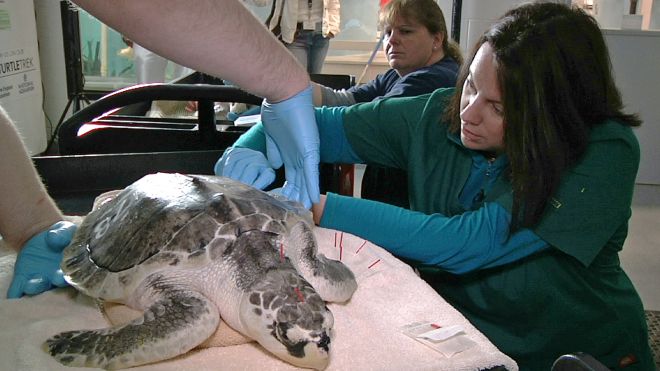Note: Lest you think that SBM is becoming “turtles all the way down,” let me apologize for the duplication and explain that I had already written this right before I read Mark Crislip’s Turtle Agony article on Friday. My focus is different, and turtles were only a small part of my article, so I decided to leave the turtles in. If you prefer to avoid a turtle overdose, you can just skip the Turtlepuncture section and go on to the Motion Style Acupuncture section. They are clearly labeled for your convenience.
The “science” of acupuncture trudges ever onward without really getting anywhere. New developments include a report of turtlepuncture and a study about treating low back pain with a new kind of “motion style” acupuncture using passive or active movement while the needles are in place. I found the first amusing and the second unconvincing.
Turtlepuncture
A group of Ridley sea turtles were rescued after being stranded during a cold spell that left them hypothermic and unable to function. In addition to the usual rescue and rehabilitation efforts, two of the turtles, Dexter and Fletcher Moon, were treated with acupuncture. It was intended to “decrease inflammation and swelling on their front flippers, restore a full range of motion on those limbs and help the animals regain their appetites.” It allegedly worked: their appetite and the use of their limbs improved. But without any controlled observations, this is only an anecdotal report and means very little. They might have recovered just as well without the treatment, for all we know.
I searched for studies on turtle acupuncture. I found studies on the miraculous turtle eight meridians method, the eight methods of intelligent turtle, turtle probing needling, green turtle searching and boring acupuncture, the extraordinary turtle flying method, and turtle probing the cave needle manipulation, and one case report of treating an American red-footed tortoise. Nothing on treating turtles.
How did they know where to put the needles? They worked with a veterinarian to find analogies between the anatomy of turtles and other animals. And acupuncture points in animals are based on analogies with humans, sometimes with amusing results: diagrams for horse acupuncture show a gall bladder meridian but horses don’t have gall bladders!
I’m glad the turtles got better, but I don’t give acupuncture the credit.
Motion Style Acupuncture
A Korean study was published in the journal Pain. It was a multicenter, randomized, controlled, comparative effectiveness trial with a total of 58 patients with acute low back pain. It compared one session of motion style acupuncture to one injection of diclofenac. Patients in the acupuncture group improved more than those in the diclofenac group.
What Is It? The authors tell us that motion style acupuncture treatment (MSAT) is a relatively novel method that has been recently used increasingly often in South Korea, but the only reference they offer refers to two case reports. In their MSAT protocol, two assistants stood on both sides of the patient with their arms around his waist. Acupuncture needles were inserted at points selected according to Traditional Chinese Medicine and previous clinical experience. The deqi sensation was not sought, but practitioners “occasionally” manually stimulated the needle at the GV16 point. With the needles in place, the patients were asked to walk with assistance. As walking improved, less support was provided. When the patient was walking without support, the needles were removed and he was asked to continue walking for 1-2 minutes. The patients were given verbal encouragement.
Why Diclofenac? The comparison treatment was a 75 mg intramuscular injection of diclofenac sodium, a nonsteroidal anti-inflammatory drug or NSAID. The rationale for choosing it as a comparison was unclear. NSAIDs have been proven effective for acute low back pain, but they are usually given orally. A recent view of acute low back pain treatment does not mention the IM option. Neither does the Mayo Clinic website. I couldn’t find any sources that recommended IM administration over the oral route. I’m guessing they chose it for this study because it was a convenient way to give one strong, rapidly acting dose for comparison with one acupuncture treatment.
Results. Pain was assessed on a scale according to subjective patient self-reports, and disability was assessed by a questionnaire at 30 min, 2 weeks, 4 weeks and 24 weeks after treatment. The outcomes were significantly better for MSAT for the earlier times but not at 24 weeks.
Does This Really Support Acupuncture? They called this a comparative effectiveness trial. Comparative effectiveness trials are typically used to compare established interventions to see which of two effective treatments is more effective. They are not intended to explore a new, untested treatment like MSAT. There are problems with this study. The subjects were Koreans who may have been culturally predisposed to expect results from acupuncture. Endpoints were subjective. Blinding was not possible. Instead of a single treatment and an atypical control, it would have been better to compare typical MSAT treatment to standard conventional treatment of low back pain.
What bothers me the most is that the MSAT group essentially got two treatments: acupuncture and assisted mobilization. I’d like to know what would happen if they got the second without the first. Maybe the needles were superfluous.
Patients with acute back pain avoid walking because it hurts. If they avoid using the muscles due to fear of pain, they can become conditioned to expect pain. Often they have severe pain when they first start walking, but if they can keep walking the pain tends to diminish. Patients who remain active recover faster; that’s why bed rest is no longer recommended. And a recent study showed statistically and clinically significant benefit from cognitive functional therapy. This involves re-framing and confidence-building as described here.
So what if all back pain patients were encouraged to walk and were assisted with the support and cheerleading? This acupuncture study would have been a far better study if it had included a motion-style treatment control group without the acupuncture component: MST instead of MSAT.
Conclusion
Color me skeptical. I question the use of acupuncture on turtles and on non-chelonian patients with acute back pain. The evidence doesn’t support it. I’m optimistic that assisted walking with physical support and encouragement might prove to be an effective treatment for patients with acute low back pain. I hope further studies will investigate that.


